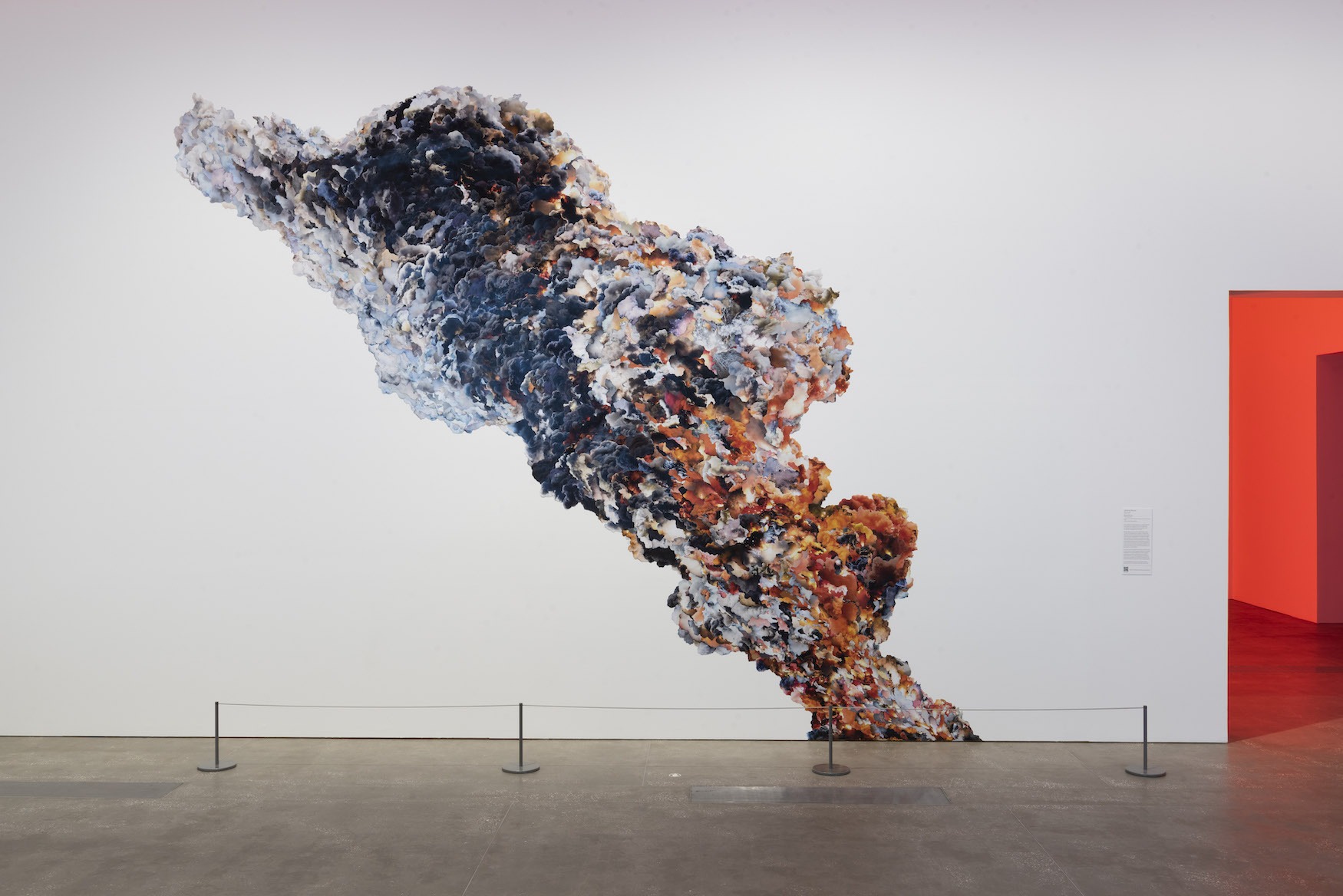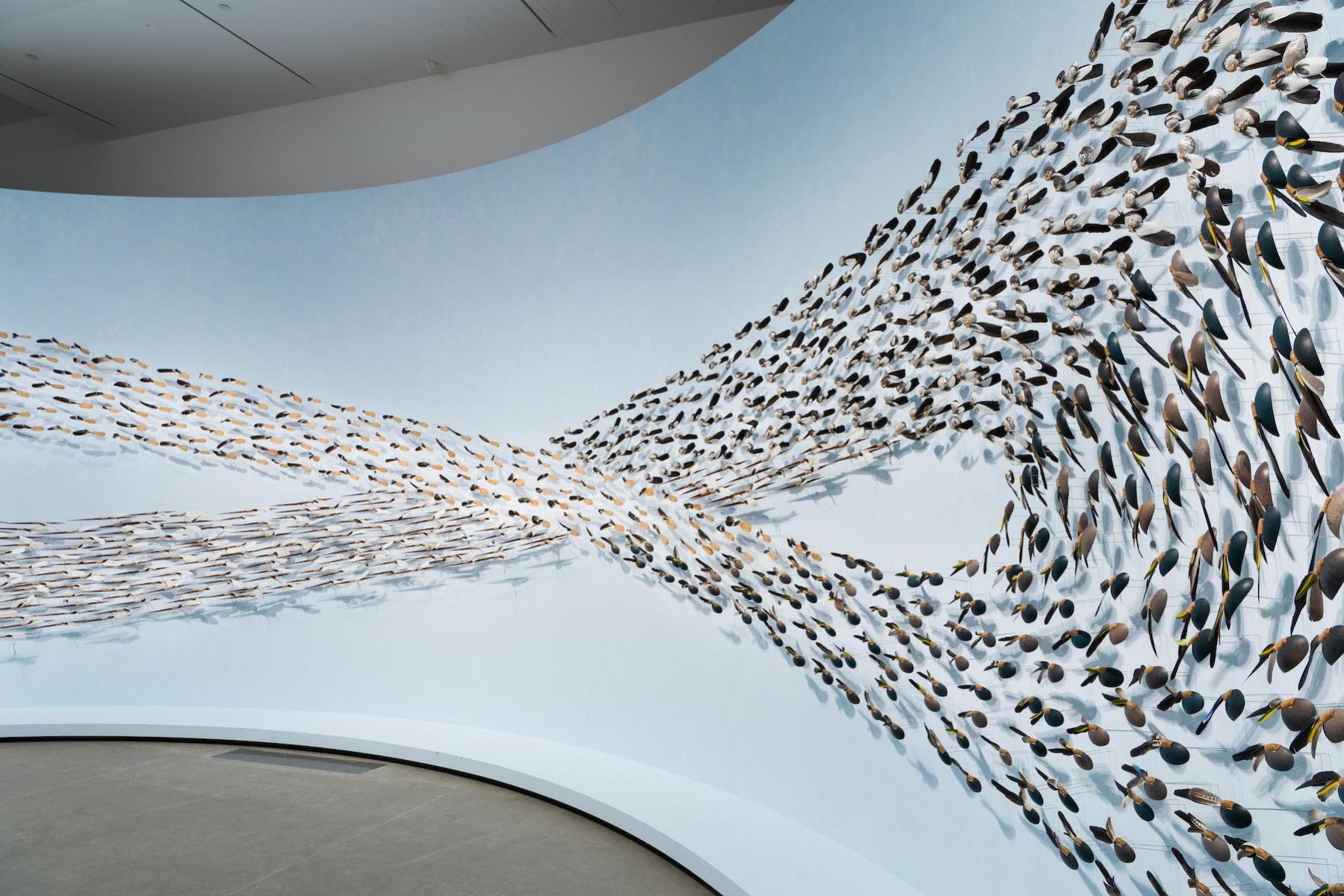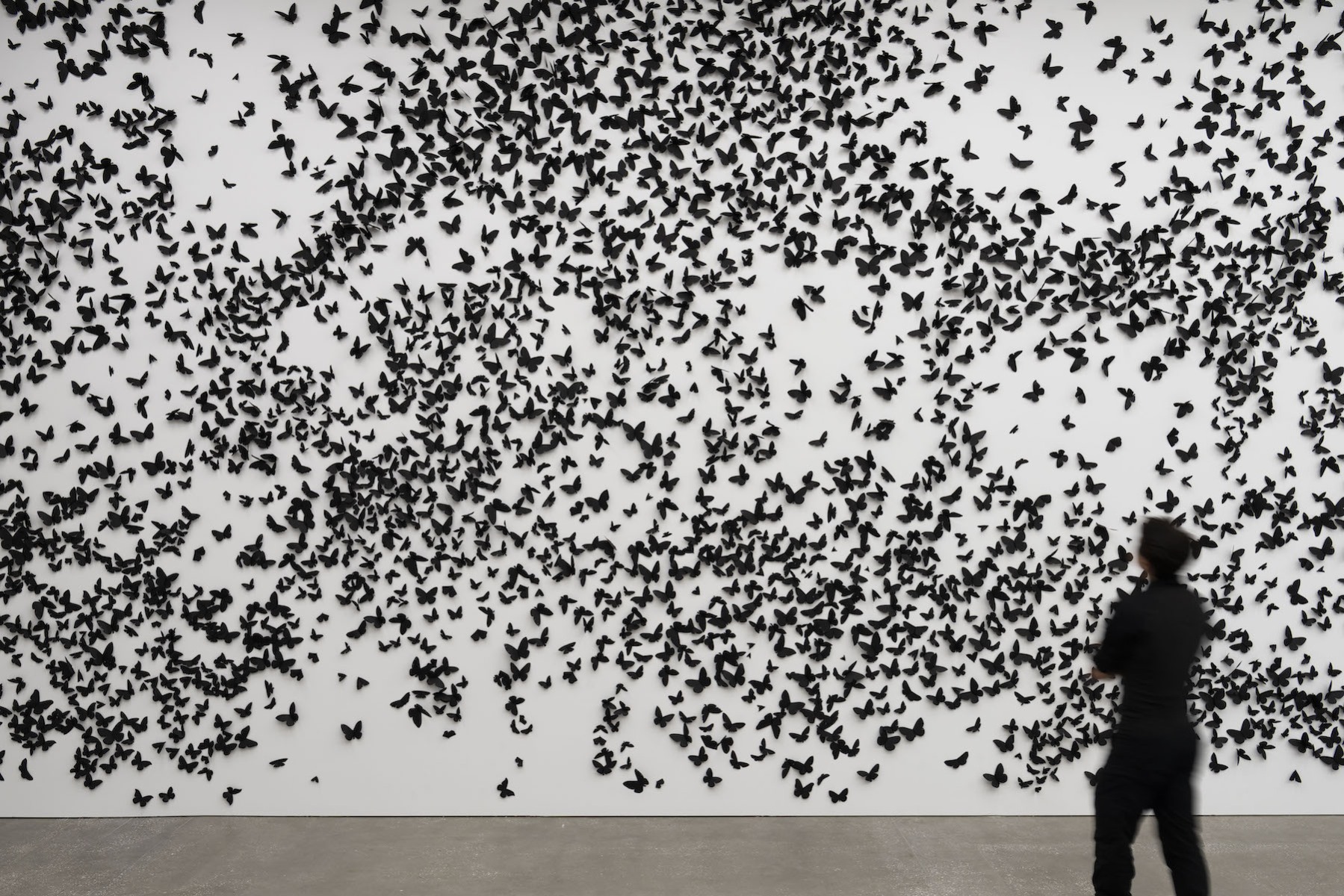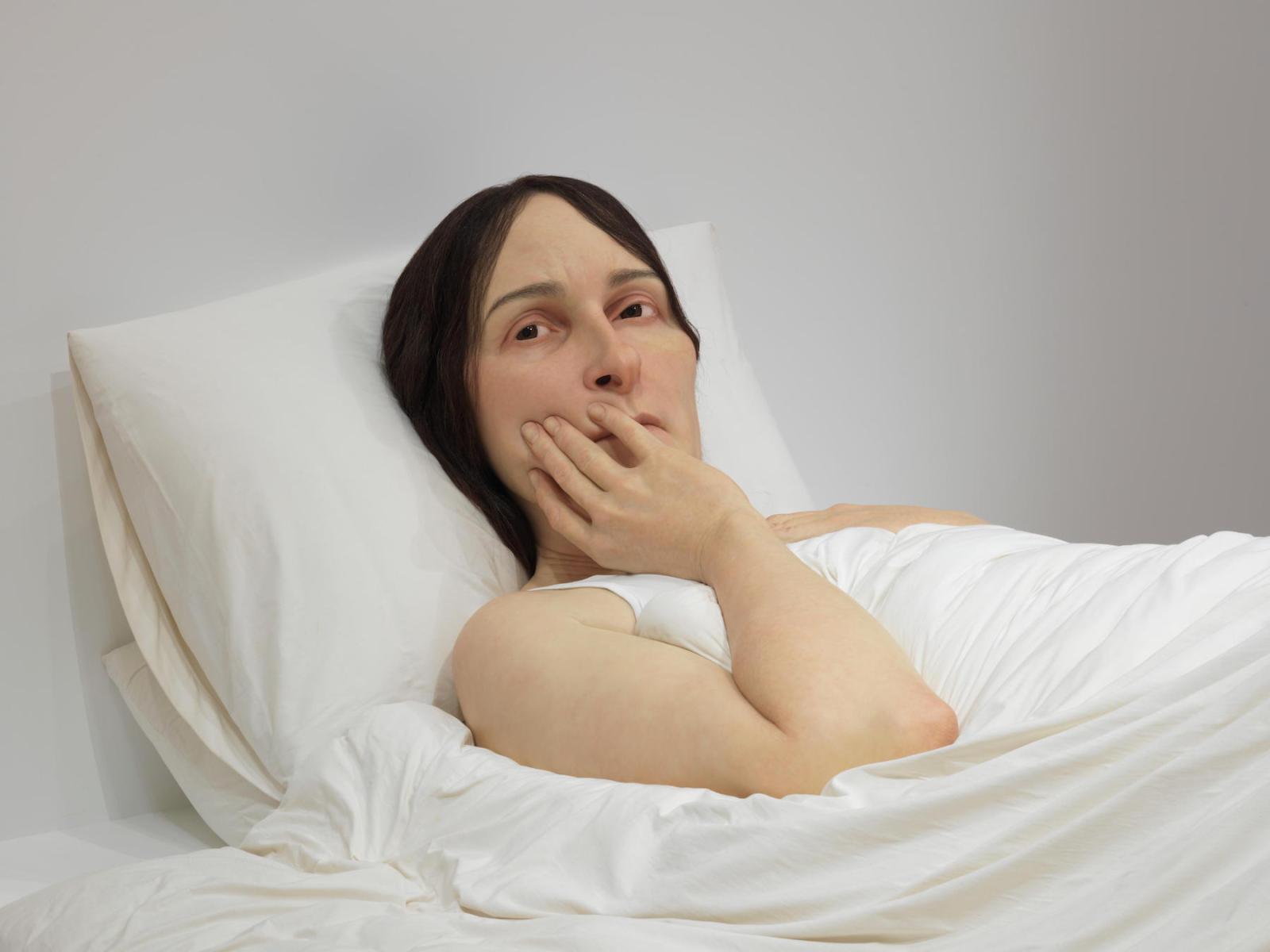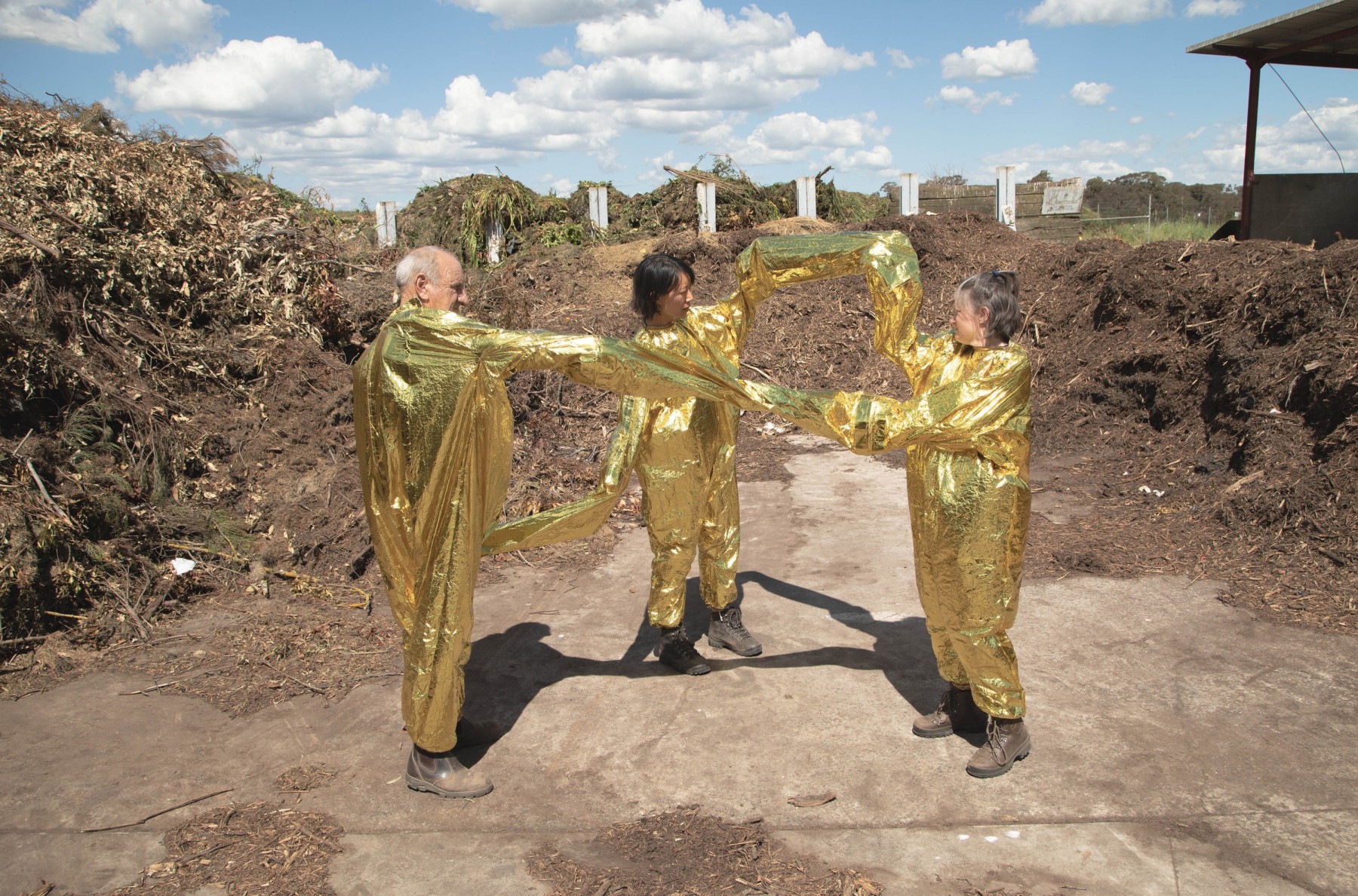The opening words of the catalogue accompanying Air, QAGOMA’s summer blockbuster exhibition, make a rather stunning assertion: “Queenslanders share the same air, from across the Torres Strait and Cape York to the Granite Belt, the Gold Coast and beyond to the wider world.” Credited to ministers Annastacia Palaszczuk, Leeanne Enoch and Stirling Hinchliffe, the statement seems to deny that air, like all resources, is unevenly distributed in its quality and in the ability to access it. Appropriately enough perhaps, the statement echoes those of politicians during the (airborne) Coronavirus pandemic claiming that we ‘are all in this together,’ even though the pandemic emphasised that some are more vulnerable than others, both economically and physically. A result to be expected given the existing (pre-covid) condition of the uneven distribution of both air and health, where those with the least socio-economic power are more impacted by the effects of pollution and are more susceptible to chronic breathlessness.[1] In a pointed juxtaposition, a proceeding catalogue essay by curator Geraldine Kirrihi Barlow, blatantly questions the ministerial statement and is titled “Do we all breathe the same air?” The answer, for Barlow, is a resounding “No.” Indeed, the phrase “we do not all breathe the same air” is repeated three times throughout her essay, almost as a refrain, an incantation, wanting to forcefully plant this idea in our mind as we approach the exhibition, that will connect air to uneven development. This bizarre mismatch between the ministerial prologue and the curatorial essay isn’t incidental to the exhibition, but rather sets the stage for the clash between curatorial ambition and institutional constraint that animates Air, and its themes, in fascinating ways.
The banner at the entrance to GOMA announcing Air includes an image of black smoke, an enlarged detail excerpted from Jemima Wyman’s Plume 20 (2022). It is a bold choice indicating that, despite the potential lightness of air, this exhibition will offer a distinctly critical and politicised lens through which to consider this element.[2] Plume 20 is a collage of found images of smoke and gas photographed at protests, and the work builds on Wyman’s existing interest in the aesthetics of protest, though in a way obviously suited to Air. The work layers and assembles countless hand cut images to form a larger image that resembles a plume of smoke. This aggregation of an enormous number of images speaks to the often-overwhelming stream of online news and media through which we watch smoke-filled air raging across a world of perpetual conflict and struggles for justice. The work also grapples explicitly with the massive and continued rise of ‘atmospheric policing’ and the use of airborne chemicals by military and police forces globally.[3] The work is a highlight of the exhibition.
With a toxic cloud introducing visitors to Air, the work of philosopher Peter Sloterdijk comes immediately to mind. Sloterdijk is an inevitable reference point for contemporary thinking around air. His work is not mentioned in the exhibition but is an important context for comprehending the exhibition’s narrative. According to Sloterdijk, an absolutely crucial event in the early twentieth century was a shift in military strategy from the direct targeting of the bodies of the enemy to the targeting of their breathable environment, as evident in chemical warfare and nuclear weapons. For Sloterdijk this is pivotal to the ongoing explication of air, and it becomes evident that “being-in-the-world is always and without exception present as a modification of ‘being-in-the-air.’”[4] Human life, considered both materially and ontologically, can never again be thought of outside of its relationship to air. From this, air conditions become central to modernity. We can no longer accept breathing in the surrounding atmosphere as a given, and air becomes a site of societal division: between those subject to increasingly toxic atmospheres and those safe in privileged air-conditioned environments. The didactics and catalogue for Air constantly refers to the recent emphasis on air in the context of the coronavirus pandemic. Via Sloterdijk we can see this as an amplification of the existing explication of air. Here one also thinks of Eric Garner’s final words, ‘I can’t breathe,’ as he was killed by police officers. Garner’s words are a powerful evocation of the differential potential of rights to air, and the right to breathe. His words have again gained further resonance for protest in the wake of the similar murder of George Floyd in 2020, again by police officers. Wyman’s work condenses these contexts of air as a continued site of upheaval, struggle, toxicity and explication, and guides my journey through the exhibition.
Upon entering Air, the central atrium includes two works by Tomás Saraceno. On one wall is We do not all breath the same air (2018): modest, framed works, containing filters that indicate air quality at various times and places. The visualisation of pollution is instantly readable, darker circles suggest more pollution, lighter indicate less. It is a succinct work that combines an almost playful formalism with an environmental agenda clearly signalled by the work’s title (yes, that phrase again). In contrast to the effective and succinct modesty of these works, most of the atrium is taken up with a massive and rather inexplicable work by Saraceno: Drift: a cosmic web of thermodynamic rhythms (2022). Drift connects to the circular motif found in the framed works, but in the form of massive inflated spheres, each with both a transparent and a silver-mirrored hemisphere, which slowly move up and down in the gallery via a motorised system. The works have a connection to the artists’ research into a technology that would allow ‘sustainable human flight.’ The idea that we will be saved by some sort of ‘technological’ solution to the climate emergency, which will thus allow us to continue a privileged lifestyle without constraint, including global travel, is one that has been widely critiqued.[5] Saraceno’s work does little to counter such critiques, nor to clearly acknowledge its own conditions of transportation and production. During my visit, its enormous mirrored curves seemed to act mainly as a unique selfie-backdrop. As the hyper-consumption of the holiday season approaches, more than anything, the spheres of Drift conjure an image of Christmas tree baubles, particularly when paired with the colourful lights that illuminate GOMA’s surroundings, including James Turrell’s nearby permanently installed Night Life.[6]
Moving further into the exhibition, a red glow settles across several of the galleries. Eventually the visitor discovers that the glow emanates from Mona Hatoum’s Hot Spot (2006). This large sculpture presents us with another sphere, this time a stainless-steel globe with a map of the earth drawn over it in neon. The work is stunning, almost too bright to look at and emits a vaguely terrifying, just audible ‘buzz’ of electric neon. Its palpable use of power creates an interesting ambiguity in the context of the work’s allusions to a warring and warming planet. The work acts as a physical, formal and conceptual centre for this section of the exhibition, clearly evoking a planet in crisis. Hot Spot’s red light seeps into the surrounding galleries and bathes nearby works in a red glow, like a warning beacon, and overtly places the surrounding works and galleries within a context of planetary emergency.
Featured in one of these nearby galleries is a snaking installation of unadorned steel ducts and pipes that constitute an iteration of Nancy Holt’s Ventilation System (1985–92). This work reminds us of the massive infrastructures that maintain the consistent and temperate climate of the gallery space it inhabits. The obvious point of orientation for this work is Reyner Banham’s history of temperature regulation in architecture, which aimed to correct what Banham saw as architecture’s obsession with the appearance of buildings to the detriment of their environmental controls. Banham is particularly noteworthy here, as his research points to the longer history of the uneven distribution of clean air, and he notes that the differential health effects of varying levels of ventilation were a matter of public record in England as early as the 1860s. This recognition of the effects of the industrial revolution on air quality would eventually lead to elaborate technologies of ventilation to maintain worker efficiency, including air-conditioning.[7] Adjacent to Holt’s work we find a selection of Charles Page’s photographs of Queensland mines and mineworkers from his ‘Journey’s North’ portfolio (1986). Here we find the even longer history of workers exposed to the dangerous and often-toxic atmospheres of mining, which has been a feature of capitalist exploitation since the sixteenth century.[8] These works document the fact that Queenslanders do not all breath the same air.
Holt’s pipes are without function, just a shell. In this sense they have post-apocalyptic overtones, alluding to a post-air-conditioning future, especially bathed in the red glow of Hatoum’s work.[9] Continuing this impression, Jamie North’s nearby work, Portal (2022) is composed of towering twin columns made of industrial waste and incorporates live plants. The works suggest post-apocalyptic ruins, in which plants have begun to reclaim human architecture. Yet they also recall the greenwashing strategies of nearby newly-built developments, where the exterior of air-conditioned high-rises are draped in plants. North’s works are, perhaps, a critique of such empty aesthetic gestures, concerned more with individualistic conceptions of self-care than community responsibility. As such, the work captures the ambivalence of environmental awareness as aesthetic affectation.
Nearby, Roslynd Piggot’s 65 bottles of air document the Melbourne-based artist’s travels through Europe in the early 1990’s (Collection of air 2.12.1992–28.2.1993, 1992–93). While having some scientific connotations, and their repetition along a single line recalling Saraceno’s framed air samples, the work is ultimately personal, almost diaristic, with each bottle hand-labelled with a reference to the place and context in which the air was collected. With the large number and intimate size of the bottles, arranged on a bespoke wooden cabinet, the work reads as an almost whimsical reorientation of Duchamp’s singular 50cc of Paris Air (1919). Though, in the context of the red glow of Hatoum’s burning-red globe, which sits in the adjacent room and is simultaneously visible, the whimsy fades and Piggott’s work could instead be read as an example of the ultra-normalisation of mass global air-travel and its disastrous environmental effects. Indeed, Air is funded by Arts Queensland’s ‘Blockbuster funding,’ which is specifically designed to create unique exhibitions at QAGOMA to encourage cultural tourism and thus presumably to amplify excessive fossil fuel-reliant air travel. Less cynically, Piggot’s work can also be read for its connection of the ephemerality of air, so difficult for human senses to grasp, to the ephemerality of human memory.
Patrick Pound’s work for Air also offers a work engaged with the metaphorical rhythm between the intangibility of both air and memory. Pound is one of the few artists in the exhibition to have a self-contained room, The air lock (2022), which presents numerous small objects and images, a sort of cabinet of curiosities. Known mainly for his collections of found photographs, Pound here presents these alongside works from the QAGOMA collection and a large, eccentric assortment of objects. Each object, image and artwork connotes ‘air’ in a different way, though sometimes, and especially with the objects, it can take a few seconds to register the reason. Pound’s approach isn’t unlike an online keyword search, and he has a work in the cabinets at the entrance to GOMA that self-reflexively uses automated online image-searches as art-making method. In this context, Pound’s work could be seen as a metonym of the wide-ranging curatorial approach to Air (as keyword search) evident in the diverse and large number of works in the exhibition. However, like Air, Pound’s work functions more affectively for the viewer than a description communicates. The work is humorous at times, but also has an effective pathos, connecting us to the human memories attached to these now discarded objects and images, and the transience of human life that they embody. Indeed, the confluence between attempts to bring air into visibility, and the photograph’s role in making memories material, unexpectedly makes Air the perfect context for Pound’s work and is an incredibly successful installation of his work. Another element that the political context of Air brings to Pound’s work, and especially the many objects, is to highlight the relentless and excessive production of novelty and newness that has transformed the air via the pollution of modernity.[10]
Returning to the gallery containing Hatoum’s work, we find on a nearby wall a vinyl text offering a direction to visitors: “SHARE YOUR EXPERIENCE #AIRGOMA.” Bathed in the red glow of Hatoum’s work, it reads almost comically, as I thought of Jonathan Crary’s recent book, Scorched Earth, which argues that there is no future for humans on a planet with the internet, as it is a world-destroying technology of extraction and exploitation.[11] Presumably not a curatorial addition, the vinyl text has been applied to walls throughout the exhibition, and furthers the tension between the curation and the institutional context.
The vinyl sits at the threshold between Hatoum’s work and a large gallery in which we find the unexpected inclusion of Ron Mueck’s massive sculpture In Bed (2005). This is an oversized, ultra-realistic depiction of a woman in bed, looking anxious and almost ill with uncertainty and trepidation. The didactic finds contemporary resonance in the the work via the context of the coronavirus pandemic, in terms of both being ill and being housebound. Yet the bed-bound condition is one that was already gathering pace throughout the twentieth century, as analysed by Beatriz Colomina.[12] This is a site not just of withdrawal, but of work, with working in bed becoming completely normalised. This is a condition enabled by communication technology and tied to the creation of individualised media atmospheres as well as the architectural atmosphere of private air-conditioned spaces, parallel to the decline of the public realm.
Rising beside the woman in bed is Wyman’s Plume 20, while her gaze looks toward the red ash-filled skies depicted in a series of photographs by Rachel Mounsey, part of her ‘Mallacoota fires in the sky’ series (2020). Further into the gallery is an installation of Cloud Chamber by Yhonnie Scarce, a dramatic gathering of hanging blown-glass works in the shape of yams. This work memorialises the devastation of nuclear testing on the artist’s ancestral Indigenous lands, while asserting the resilience and renewal of the people and cultures that have forever dwelled there. Beyond Scarce’s work, a monumental work on paper by Thu Van Tran, Rainbow Herbicides (2018), includes detailed monochromatic drawings of clouds that evoke explosions, war, and terror. These are overlaid with a dramatic scar of spray-painted colours, which refer to the chemical warfare to which Vietnam was subjected by the US military, including, most notoriously, Agent Orange. The troubled figure in bed, rendered by Mueck, acts as the paralysed, horrified audience of these histories and their continued legacies, a world on fire, a public from which she is seemingly withdrawn and powerless. The combination of the five works in this gallery, with the red glow of Hot Spot seeping over the walls and through the doorway, is a triumph of curation. The power of each stunning individual work is held, while the resonance between them aggregates into a singular, overwhelming and deeply affective experience.
Elsewhere, (untitled) giran (2018) by Jonathan Jones with Uncle Stan Grant Snr, returns to the galleries (last exhibited at GOMA in APT 9). The work presents hundreds of traditional Indigenous tools in a dramatic arrangement. Spread across the walls, almost like a flock of birds in flight, they form the symbol for infinity and suggest the endless potential of this collection of tools. The work lays bare how misleading the term ‘anthropocene’ is, for there are many human cultures that have made no lasting negative impact on the environment. Another work in Air with similar implications, is As I remember it (H2) by d Harding with Hayley Matthew, which is composed of the impressions left on paper by ochre blown from the artists’ mouths over Indigenous tools that are then removed. A crucial element of (untitled) giran is the inclusion of a didactic that lists the dozens of collaborators from which the tools were sourced, indicating the importance of process and community to the work. This can be contrasted with Black Cloud (2007/2008) by Carlos Amorales, another massive work in Air, with which it shares some visual similarities. Black Cloud consists of 30,000 laser-cut paper butterflies, laid in swarms across the walls and ceiling, infesting an otherwise bare, brightly-lit gallery. These paper butterflies have been anonymously produced and assembled, their process rendered invisible, culminating in a work that feels empty and self-consciously EPIC. Like Saraceno’s Drift it was a popular selfie spot that distracted from the exhibition’s political, post-Sloterdijk, narrative.
Another major work in the exhibition is a large installation by Anthony McCall, Crossing (2016). McCall’s formal experiment, which uses haze machines to make visible points of light from multiple video projectors, felt out-of-place. It immediately made me think of HeHe’s Nuage Vert (2010): outdoor laser projections on to clouds of pollution that rendered them a dramatic green. HeHe’s work is formally and technologically innovative, like McCall’s, but with a politicised edge that pushes beyond the gallery walls. Or think of Hehe’s remote-control cars, sent into the streets billowing colourful smoke from their ‘exhausts’ (Toy Emissions, 2007).[13] The inclusion of McCall’s formalist experiment with atmospheric conditions emphasises how bound to the interior spaces of the gallery this exhibition on ‘air’ is. There are gestures to outdoor works: the catalogue brings the permanently installed Bodhi Tree Project (2006), situated in the gardens of GOMA, into the curatorial premise of the exhibition. And Katie Paterson’s innovative work of bespoke incense sticks (To Burn, Forest, Fire, 2021), burnt outside each morning, briefly takes the exhibition beyond the air-conditioned gallery (though the burnt sticks are then displayed in the gallery). The minimalism of these inclusions only serves to emphasise the constraints of the exhibition’s gallery-object requirements that sit uncomfortably with its curatorial ambition.
I have really only scratched the surface of this deeply considered and complex exhibition and have left many works undiscussed, including brilliant video works by Oliver Beer and Jananne Al-Ani. I left the exhibition feeling invigorated, yet conflicted. As I reflected on the exhibition, Marx and Engel’s famous line “All that is solid melts into air” seemed particularly appropriate. With this term Marx and Engels were evoking the incessant change that defines modernity, leaving us unable to grasp the present amidst the turbulence of change, unable to find a solid ground from which to get our bearings. In many ways this exhibition evokes this feeling, presenting an at-times kaleidoscopic journey through the ‘air’ of modernity, and its forces and intensities. Air attempts to bring this ‘air,’ used by Marx and Engels as a metaphorical evocation of invisibility, into visibility, to understand the forces that are shaping the material conditions of air. This dialogue between visible and invisible, concept and material creates a fascinating and memorable exhibition.
This week’s review was kindly edited by Editorial Advisor, Hamish Sawyer.
[1] See: David Fuller, Jane McNaughton, and Corinne Saunders, “The Life of Breath: Contexts and Approaches” The Life of Breath in Literature, Culture and Medicine (London: Palgrave, 2021): 1-31.
[2] The Matter of Air, presented at Gertrude Contemporary in 2011, treated air purely as a formal resource for relatively abstract artistic experimentation. I left that exhibition bewildered by its lack of acknowledgment of air as a political object, doubly odd given that Peter Sloterdijk’s Terror from the Air had been translated two years earlier and was being widely discussed throughout the humanities. The lingering memory of that exhibition gave me some trepidation in approaching Air, to which the use of Wyman’s work in the promotional material was a welcome antidote.
[3] See: Markin Nieuwehhuis, “The Politics of Breathing: Knowledge on Air and Respiration” Atmospheres of Breathing, Eds. Lenart Škof and Petri Berndtson (Albany, NY: SUNY, 2018): 199-218.
[4] Peter Sloterdijk, Terror from the Air (2002) Trans. Amy Patton and Steve Corcoran (Los Angeles: Semiotext(e), 2009): 93.
[5] This is a key theme in several works by T.J. Demos, such as Against the Anthropocene and Decolonizing Nature.
[6] For a critique of Night Life, see local artist Marisa Georgiou’s recent self-published zine, Affect Eclipses Meaning: Art, Capitalism and Affective responsibility (2022).
[7] Reyner Banham, The Architecture of the Well-tempered Environment, Second Edition (Chicago: University of Chicago Press, 1984): 30-31.
[8] John Durham Peters provides a succinct summary of research into this longer history, see: “The Media of Breathing” in Atmospheres of Breathing, 187.
[9] On the broader cultural imagination of post-air-conditioning futures, see, Julia Leyda, “Post-air-conditioning Futures and the Climate Unconscious” Screen 62.1 (2001): 100-106.
[10] As J.R. McNeill and Peter Engelke argue, climate change is a result specifically of consumerism, rather than population growth. The Great Acceleration: An Environmental History of the Anthropocene Since 1945 (Cambridge, MA: The Belknap Press, 2014): 117.
[11] Jonathan Crary, Scorched Earth: Beyond the Digital Age to a Post-Capitalist World (London: Verso, 2022).
[12] Beatriz Colomina, “The Office in the Boudoir” Agenda (Zürich: Lars Müeller, 2014): 81-87.
[13] For a detailed overview of Hehe’s innovative work, see: Hehe, Man Made Clouds (Orléans: Editions HYX, 2016).
Kyle Weise is co-director of Kuiper Projects and the curator (exhibitions program) at Metro Arts.

